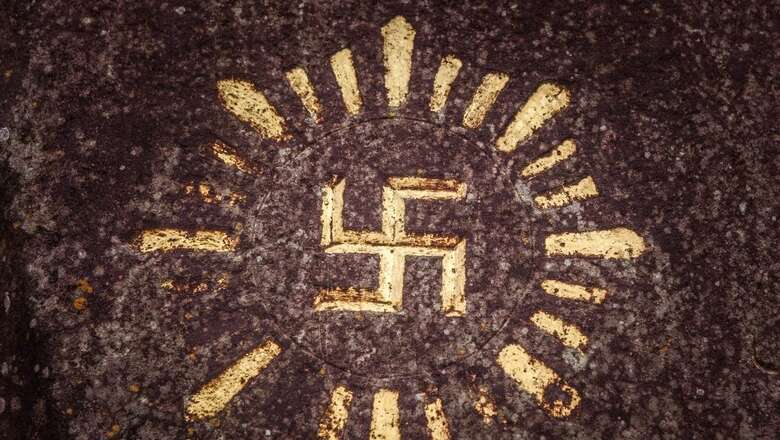
views
Cries can be heard on the streets of Maryland, USA. Crowds marching together, holding signs, protesting that their religious expression is taken away. Hindu American foundations have been painstakingly organising campaigns across the United States to educate the American public on the true meaning of the Swastika. They have been holding rallies and doing interviews to explain that Swastika is a historic symbol of peace and has nothing to do with the Nazis.
Unfortunately, they have a long road ahead. Their pleas have fallen on deaf ears. The United States of America (Maryland House Bill 0418) was passed recently banning all images and recreations of the Swastika as hate speech and hence illegal. This would greatly impact all existing temples, Hindu associations, and even the household pujas.
To move towards taking away rights from Hindus to peacefully practice their region is nothing new. The US is not the only country to have banned the Swastika. Australia’s ban on any sale of items of Nazi symbols includes the Swastika, effectively stiffing the religious freedoms of Hindus, and classifying anyone wearing the Swastika as an anti-social element.
These bans are not something new. In fact, the US and Australia are only the two most recent countries to have passed laws banning the use of the Swastika due to its association with the Nazi party. Such bans can be found in nearly all parts of the world including Brazil, Japan, Korea, France, Spain and many more. As per the last count, nearly 20 countries across the world have laws banning the Swastika. One might say that this is, in fact, right. We should not continue the use of symbols that have caused so much pain to the people.
However, is the world trying to overcorrect to essentially further victimise innocent individuals? Without going into the real issue, what is currently happening is that a community is being made a scapegoat for the misdeed of the other.
These lawmakers say that the banning of the Swastika is important due to it being used in the Nazi flag. This sentiment is still propagated by the Western media. As of June 2023, an article by the BBC describes the Nazi swastika as a derivative of an ancient hooked cross motif which remains a sacred symbol in Hinduism, Buddhism and Jainism.
Let us look into the history of this statement. Is the Nazi cross the same as the Swastika? Why would the Nazis, who openly believed in the superiority of the white race, want to associate with cultures from the east? To understand this strange paradox, we would first have to look at the history of how the Nazi cross came to be.
The Nazi cross is considered one of the most recognisable symbols from Hitler’s regime (from 1933 until his death in 1945). It was found in all sorts of Nazi paraphernalia. Be it the Nazi flag, arm bands, school uniforms. If the cross could be added, it was added.
Symbols and motifs are often recycled from history as they already have certain associations to meaning or cultural collective consciousness. Here is where it becomes very curious. Hitler had made no secret of his belief that some races were better than the rest. Various instances from his life and speeches suggest that Hitler considered Hindus and Indians, at large, to be a low race. He often proclaimed the superiority of the white race and considered the British race superior to that of the Indian race and stated that the colonising of India was a good thing.
Considering his lack of favour towards Indians, it makes it very curious as to why he would go out of his way to adopt the Hindu Swastika as the face and base of his political might? In his book ‘Mein Kampf’, Hitler used the word ‘Hakenkreuz’ eight times. This word has been translated to mean Swastika but its true meaning is understood by breaking down the combination word. The breaking of the combination word leaves us with Haken and Kreuz. Alternatively read and understood as the Hook Kross. The Hook Kross has an extensive history and symbolism of its own. It has been used by various countries in the past. For example, Finland’s Air Force used this symbol from 1918 to 2020 and Britain’s County Council bore it in 1939. A 1913 yearbook from Westfield High School in the US referred to this symbol as ‘Gammadion’.
A German archaeologist named Heinrich Schliemann found the remains of the ancient city of Troy in 1875. He documented that such symbols were found in the remains of buildings and sculptures. In 1885, he published a book called ‘Ilios’ and used the word Swastika to describe this symbol. In this book, he stated that Swastika meant the cross. This misleading confluence was challenged by many of his peers. Max Muller being one of them. Muller, who had extensively studied Indian cultures, was adamant that the Swastika originated in India and did not mean the cross. If the word Swastika was used to describe similar-looking symbols that did not hold the same meaning, it would only lead to misunderstanding and confusion among the larger public.
It is not uncommon for similar-looking symbols to be used throughout history. However, they should not be confused with one another if their meanings aren’t the same. After extensive research, it was clear that the Hooked Kross was referred to by different names such as ‘Fylfot’. Similarly, in Greek, it was often referred to as ‘Gammadion’. At that time, it was assumed that the name was a combination of the Greek letter Gamma and the number 4.
Some scholars have suggested that Gammadion as a symbol represents stability or foundation. This meaning is inferred as it looks like a cornerstone. When extrapolated into a religious sense, it can also be used to refer to Jesus Christ.
According to the Bible, Jesus Christ is the cornerstone of Christianity. God is often shown to refer to Jesus Christ as the cornerstone of his people. In this interpretation, Gammadion becomes a sign of Christianity itself. This could explain why so many historical monuments and churches retain this symbol. A few examples are found in the Church of Ireland, Hagia Sophia Church of Istanbul, 10th-century Christian manuscripts, and the Church of Lalibela.
Hitler was known to have been active in his local church growing up. This local church had this Hooked Kross carved eight times into its architecture. Due to his close association with the church, it is assumed that he used the cross he saw in church windows, which were visible from his childhood home, rather than for its relevance to other religions or cultures. To corroborate this claim, we can refer to his speech given in Munich, Germany on October 25, 1930. During this speech, Hitler called ‘Hakenkreuz’ a part of the Christian tradition. A symbol of the struggle against Jews, Marxists, and Bolshevik.
In 1920, the Nazi Party of Germany also published a 25 points propaganda on German religion. Point number 24 stated that the Nazi party was based on Christianity. Hitler also considered Jesus as a great warrior and this symbol’s association with Christianity and Christ himself may have been a major reason for its popularity. Having traced the history of the Hooked Kross, it is evident that it is not associated with the Hindu Swastika. Unfortunately, the carelessness of the Western media and their constant reference to the Hooked Kross as Swastika has led to the degradation of a sacred symbol standing in peace and life cycle.
Considering India’s extensive record showcasing its value for peace and protection, how did the Swastika, present in nearly all pujas and ceremonies, become associated with the domination of the Jews? To understand this clever sleight of hand, we must look into the role of the media in misleading the public.
It is rarely acknowledged that India was one of the largest contributors (2.5 million men) to the Allied forces to fight against the Nazis. Indian blood soaks the battlefields where they defended the rights of Jews. In fact, Indian leadership delayed its own independence movement to ensure the troops could focus on leading Jews to safety. India has always maintained that the genocide done by the Nazis was an abhorrent stain on the world’s history. This however is never mentioned. None of the world war movies ever show men of colour to show the sacrifice Indians made for the betterment of all and not just themselves. What is however shown is the false equivalency between the Hooked Kross and the Swastika despite all of the evidence pointing to the extensive Christian history of the cross. It was widely recognised all across Europe for its Christian originals.
In 1931, when Hitler’s Mein Kampf was translated into English by E.T. Dugdale, there was no mistaking it as the Swastika. However, by 1939, the book was translated again by James Murphy. In this re-translation, the “Hakenkreuz” was suddenly referred to as the Swastika. It can be theorised that this reinterpretation of the symbol was done to distance it from its original Christian roots. To have the symbol be associated with a relatively unknown culture in Europe i.e. Hinduism. The success of this version of the Mein Kampf far superseded the success of its predecessor. The popularity of this book single-handedly changed the symbol of well-being to the symbol of hate, persecution, and evil.
James Murphy was a Christian priest. He had ulterior motives to ensure that the massacre of Jews was not as closely associated with Christianity, even though Hitler had openly claimed it so in the original book. It would not have served well if the deadliest wars on European soil were openly in the name of Christianity, especially after the Middle Ages. It also did not serve the British interest in their colonies where they were supposedly on a “civilising mission”. If the white man could be so brutal in their own land to their own people, they would have no justification in calling anyone else “savages”. For Britain’s economic power and moral high ground, it was imperative that the Nazis were not associated with Christianity but with a different religion. It worked in their favour that they were able to associate it with Hinduism. They already had their colonial interests in India and could further use this as a reason for why the British must save the native Indians and civilise them.
This false association was bolstered by the media. As is done by the BBC (British state-run media house) still drawing parallels between the two very different symbols. The false propaganda of associating Nazis with Swastika is so pervasive that it is present in movies, articles, publications, popular media and so on. Hindu children have reported being bullied for drawing a Swastika outside their door during Hindu festivals as Western children only associate it with violence and Nazis.
Countries have a responsibility towards their citizens to protect them from hate speech. However, when the supposed hate speech is based on a false equivalency, the issue becomes a lot more complicated.
There is no doubt that the genocide done by the Nazis was an abhorrent stain on the world’s history. The systematic killing of six million individuals is and will always be one of the greatest crimes conducted against humanity. Having said that, the price of these horrid acts should not have to be forced to be paid by a community with no ties to the Nazis and who have used Swastika in a peaceful religious context for centuries.
The controversy surrounding the Swastika is a complex interplay of history, religion, and translation. Hitler’s use of the symbol, combined with its Christian associations, played a crucial role in shaping the symbol’s perception and current associations. The transformation of the Swastika into a symbol of hatred through translation is a testament to the power of language and its ability to shape historical narratives. Due to the Western bias, this sordid history has not been corrected as the perpetuation of these narratives helps the dominant class.
As access to alternative historical records becomes more readily available, we must fight to correct these inaccuracies and biases.
Vijita Singh Aggarwal is a professor of international business at Indraprastha University. Views expressed in the above piece are personal and solely that of the author. They do not necessarily reflect News18’s views.















Comments
0 comment